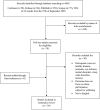The influence of blue light on sleep, performance and wellbeing in young adults: A systematic review
- PMID: 36051910
- PMCID: PMC9424753
- DOI: 10.3389/fphys.2022.943108
The influence of blue light on sleep, performance and wellbeing in young adults: A systematic review
Abstract
Introduction: Blue light from electronic devices has a bad reputation. It has a wavelength which may influence our circadian rhythm and cause bad sleep. But there are other aspects of blue light exposure which are often overlooked, for example, it may influence performance and wellbeing. However, few resources summarize its effects systematically. Therefore, the goal of this systematic review was to distil the present evidence on blue light exposure and its influence on sleep, performance and wellbeing and discuss its significance for athletes. Methods: The databases that were searched were Cochrane, Embase, Pubmed, Scopus, and Virtual Health Library. The studies included investigated the influence of blue light exposure on either sleep, performance, wellbeing or a combination of those parameters on healthy humans. Quality assessment was done based on the quantitative assessment tool "QualSyst." Results: Summarizing the influence of blue light exposure, the following results were found (expressed as proportion to the number of studies investigating the particular parameter): Fifty percent of studies found tiredness to be decreased. One fifth of studies found sleep quality to be decreased and one third found sleep duration to be decreased. Half of the studies found sleep efficacy to be decreased and slightly less than half found sleep latency to be increased. More than one half of the studies found cognitive performance to be increased. Slightly more than two thirds found alertness to be increased and reaction time to be decreased. Slightly less than half of the studies found wellbeing to be increased. Conclusion: Blue light exposure can positively affect cognitive performance, alertness, and reaction time. This might benefit sports reliant on team-work and decision-making and may help prevent injury. Blue light might also have negative effects such as the decrease in sleep quality and sleep duration, which might worsen an athlete's physical and cognitive performance and recovery. Further research should explore if blue light can improve sleep, performance and wellbeing to significantly benefit athletic performance.
Keywords: cognitive performance; exercise; physical activity; recovery; sleep quality.
Copyright © 2022 Silvani, Werder and Perret.
Conflict of interest statement
The authors declare that the research was conducted in the absence of any commercial or financial relationships that could be construed as a potential conflict of interest.
Figures
References
Publication types
LinkOut - more resources
Full Text Sources
Research Materials


